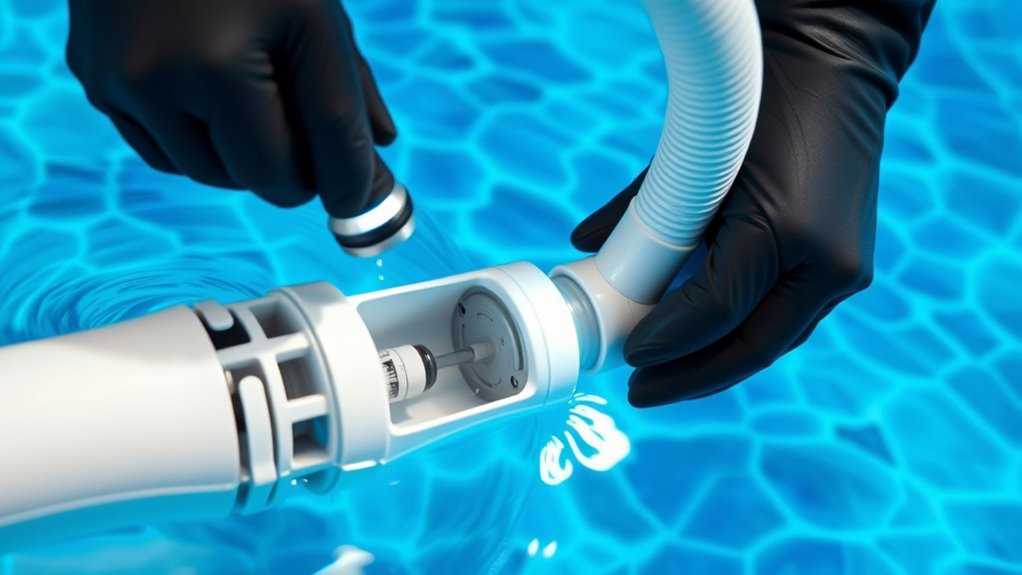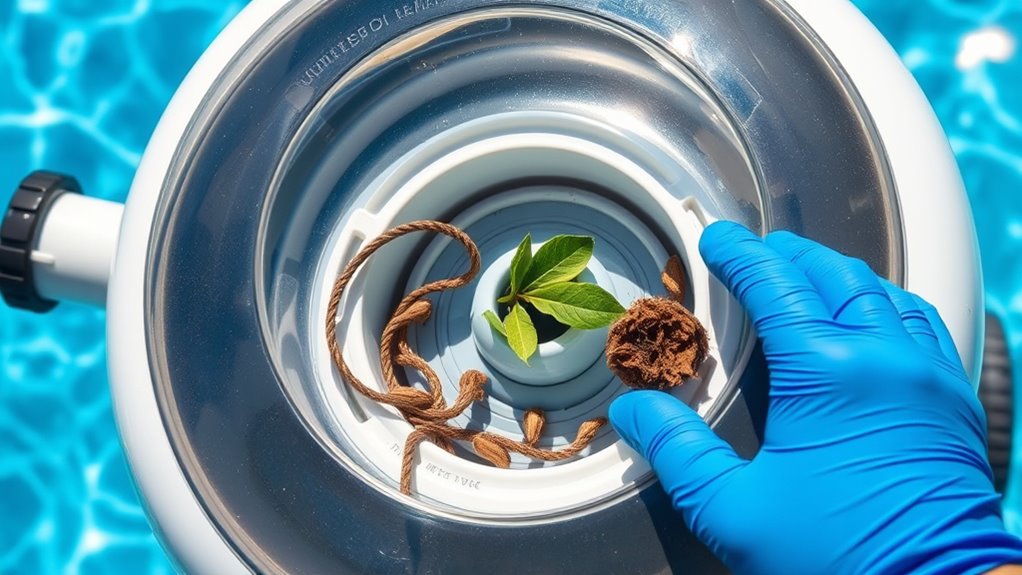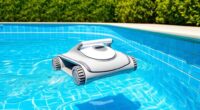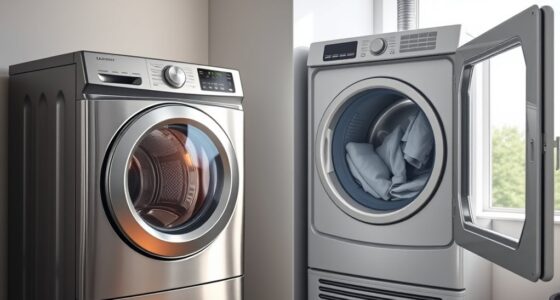If your suction pool cleaner is not working well, start by checking for blockages or debris in the hose and filters, which can reduce suction. Examine the hose for leaks, cracks, or kinks, and make sure all connections are secure. Adjust the float and weight settings to guarantee proper movement. Regular maintenance and proper setup usually fix common problems, but more tips await if these steps don’t resolve your issue.
Key Takeaways
- Inspect and clean the suction hose for leaks, cracks, or kinks to ensure proper water flow.
- Check and clear debris from skimmer baskets, filters, and brushes regularly.
- Verify correct weight distribution, float settings, and proper positioning for balanced movement.
- Ensure all hose connections are secure and sealed tightly to prevent air leaks.
- Follow manufacturer instructions for setup and calibration, and seek professional help if issues persist.

A suction pool cleaner is a convenient way to keep your pool spotless, but when it stops working properly, it can be frustrating. One common issue is that the cleaner may lose suction or fail to move correctly. To troubleshoot effectively, start with some basic pool cleaner maintenance. Regularly check the cleaner’s parts and confirm everything is in good shape. Over time, debris, dirt, and algae can clog or wear out components, reducing performance. Keep the brushes clean and replace worn-out parts as needed. This proactive approach helps prevent bigger problems down the line.
Regular maintenance and part checks keep your suction pool cleaner working efficiently.
A key step in troubleshooting is performing a suction hose inspection. The suction hose connects the cleaner to your pool’s skimmer or dedicated suction port, and if it’s damaged or obstructed, the cleaner won’t operate properly. Carefully remove the hose and inspect it for cracks, holes, or leaks. Even small punctures can cause a significant loss of suction, making the cleaner less effective. While inspecting, also check the hose for any kinks or twists that might restrict water flow. Straightening out or replacing the hose can often restore proper suction and improve the cleaner’s movement. Additionally, ensuring the hose is properly connected and sealed reduces the risk of air leaks that can diminish suction power.
Next, verify that the cleaner’s intake and filter are clear of debris. A clogged skimmer basket or clogged filter can reduce suction, affecting the cleaner’s performance. Remove the debris and clean the filter thoroughly, ensuring there’s nothing obstructing the flow of water. Also, check the cleaner’s brushes and wheels, removing any debris caught in them. If the brushes are worn or damaged, replacing them will boost cleaning efficiency. Proper digital literacy and understanding of your equipment can also help you troubleshoot more effectively in the future. Developing a routine maintenance schedule ensures small issues are caught early before causing more serious problems.
Another common cause of trouble is improper weight distribution or incorrect positioning. Make sure the cleaner is properly balanced and that the float or weights are set correctly. If your cleaner has adjustable parts, fine-tune them to improve its movement across the pool surface. Sometimes, the cleaner simply needs to be repositioned to ensure it covers all areas evenly. Proper installation and setup are crucial for optimal performance. Ensuring correct setup can often prevent issues related to uneven cleaning or poor movement. It’s also helpful to periodically check for any wear and tear that might affect the cleaner’s operation.
Additionally, considering the importance of a high contrast ratio in visual clarity, ensure your pool’s lighting and water clarity are optimal, as poor lighting can make it harder to spot issues or debris.
Finally, if you’ve inspected everything and the cleaner still isn’t functioning properly, consider checking the pool’s water level. A low water level can reduce suction power. Keep the water at the recommended level to maintain ideal suction. If all else fails, consulting the manufacturer’s manual or calling a professional can help identify more complex issues. Regular pool cleaner maintenance and thorough suction hose inspection are the best ways to keep your cleaner running smoothly and avoid unexpected breakdowns.
Frequently Asked Questions
How Often Should I Replace the Filter Bag?
You should replace the filter bag based on your filter maintenance routine and the replacement schedule suggested by the manufacturer. Typically, check the filter bag weekly, and if it’s full or visibly dirty, replace it to guarantee maximum cleaning. During heavy pool use or debris, more frequent replacements are necessary. Regular maintenance keeps your cleaner working efficiently, extending its lifespan and maintaining clean, clear water.
Can I Use My Suction Cleaner on Saltwater Pools?
Can your suction cleaner dance through saltwater pools? Absolutely, with saltwater compatibility, it can handle the brine without missing a beat. To keep it performing like new, focus on corrosion prevention—rinse it thoroughly after each use and avoid prolonged exposure to salt. This rhythm of care guarantees longevity, so your cleaner stays in sync with your pool’s needs, making every swim smooth and worry-free.
What’S the Ideal Water Ph Level for Optimal Cleaning?
For ideal cleaning, keep your pool’s water pH level between 7.2 and 7.6. Proper pH balancing ensures your suction pool cleaner works efficiently and reduces wear. Regular chemical treatments help maintain this level, preventing algae and mineral buildup. Test your water frequently, especially after heavy use or weather changes, and adjust with pH increasers or decreasers as needed. This keeps your pool clean, safe, and easy to maintain.
How Do I Prevent Tangling of the Hoses?
Tangled hoses can be frustrating, but with proper hose maintenance, you can prevent this. Always check for kinks and twists before use, and keep hoses straight during operation. Using a reel storage system helps manage hoses, reducing tangling and prolonging their lifespan. Regularly inspecting and coiling hoses correctly makes cleaning easier and keeps your pool cleaner. Don’t worry—these simple steps make hose management straightforward and keep your cleaner working smoothly.
Is It Safe to Leave the Cleaner in the Pool Overnight?
Leaving your pool cleaner in the pool overnight is generally safe, but consider pool safety and overnight storage. Verify the cleaner is turned off and properly stored to prevent accidents or damage. If you have children or pets, remove or secure the cleaner to avoid hazards. Regularly check the device for wear and tear, and follow manufacturer instructions for overnight storage to prolong its lifespan and maintain pool safety.
Conclusion
If your suction pool cleaner isn’t working properly, don’t assume it’s broken beyond repair. Sometimes, the issue might be as simple as a clogged hose or an improperly positioned float. Interestingly, some experts believe that algae buildup can also reduce efficiency, even if you don’t see visible signs. By checking these common problems, you can often get your cleaner back in action quickly and save money on replacements. Keep troubleshooting—you’ll have a sparkling pool in no time!









